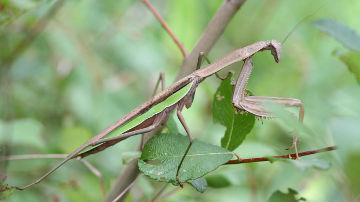

PHOTO COURTESY OF GARRY KESSLER
Chinese mantids like this one and similar-looking European mantises, often called praying mantises, wait in vegetation to ambush and eat other insects.
October 27, 2017, Page A6
NATURE NOTES
By Annie Reid
Westborough Community Land Trust
Insect eaters of insects
Thanks to this year’s unusually summery October weather – with no prior frost to make it an “Indian summer” – we’ve still been hearing insects on warm nights (crickets and katydids) and finding insects in the garden, woods, or fields by day. One that you might spot lurking in the vegetation is a mantid, waiting for its prey of other insects to come along.
In New England we have two kinds of mantid: the true “praying mantis” or European mantis (Mantis religiosa), and the Chinese mantid (Tenodera aridifolia). As their names suggest, both are non-native species, introduced in the 1890s to eat insect pests. Both sit in a position that reminds us of prayer, so both often get called praying mantises. Both can be either green or brown – good camouflage colors.
There’s a size difference: the European mantis is about 2 inches long, while the Chinese mantid is about 3 inches. Both have a long, gangling appearance that helps them to hide among the sticks and stems of vegetation. They remain still for long periods and move slowly, so you can get a good look if you spot one. In some cultures, mantids are symbols of stillness, or of meditation or contemplation. But they’ll fly off if you make a sudden move.
We tend to think of insects as troublesome creatures that bite us or devour our plants or crops, but mantids do neither. Other insects are their main prey. They hunt by ambush – sitting still and waiting, and then grabbing their prey with their front legs, which bear spines. They watch for prey with five eyes of two types (but none are like ours). They hear prey with an eardrum-like organ on the underside of their body.
They’re not fussy eaters, so they’ll capture whatever comes along, including another mantid. In the western U.S., some large mantids have been reported as catching and eating occasional hummingbirds.
In our area, Chinese mantids and European mantises have not worked out particularly well for pest control because they eat all kinds of insects, including each other, and not just the “bad” insects that gardeners and farmers would like to target.
Fall is the mating season for mantids, although this activity can be risky for the males. Females are larger than males and will sometimes eat a male, head first. Surprisingly (to us), mating can take place even after the male has lost his head. That’s due to a nervous system that’s more decentralized than ours is.
Female mantids lay groups of eggs on branches, stems, rocks, or buildings. Chinese mantids often choose goldenrod stems. Females cover their eggs with a fluid that hardens into a protective case which helps the eggs to survive the winter. In the spring, a batch of perhaps 100 young mantids hatches from an egg case. They’ll start eating each other if they don’t find enough food. The young that survive will molt several times, shedding their “skin” or outer “skeleton” when they outgrow it.
There are many species of mantids in the world, but most are tropical or subtropical insects.
As frost becomes more and more likely in our area, enjoy keeping an eye out for Chinese mantids and European mantises. Look for them in gardens and weedy places, such as the sides of roads, trails, and parking lots, and vacant lots and parks.
Date index
Month (October)
Common name index
Scientific name index
Category index